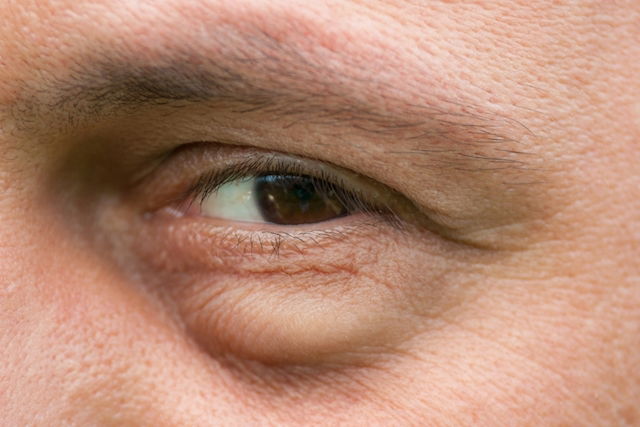Puffy eyes may occur as a result of allergies, direct blows to the eyes, insect bites, pregnancy, a stye, pin eye or blepharitis. Eyes can become swollen due to an accumulation of fluid in the tissue that surrounds the eyes, like the eyelids or glands.
In rare cases, puffy eyes may be a sign of a more serious health condition, like abnormal thyroid functioning, kidney problems or an eyelid tumor. These situations will typically cause swelling in other areas of the body, like the face or feet.
Puffy eyes that persist for more than 3 days should be assessed by a doctor for diagnosis and treatment. Treatment may involve the use of antibiotics.

Puffy eyes are mainly caused by:
1. Allergies
Allergies are one of the most common causes of puffy eyes. Eyes can become swollen with either respiratory allergies, contact allergies or a food/medication allergy. In addition to swelling, it common for eyes to become teary and for other symptoms to emerge, like a stuffy nose, runny nose, sneezing and itching.
What to do: It is important to consult a doctor to determine the allergy trigger. The doctor may prescribe medications to manage symptoms, such as cetirizine or hydroxyzine, which will help reduce puffiness in the eyes.
2. Stye
A stye is characterized by an inflammation of the glands in the eyelids caused by infection. It leads to swelling in the eyes, particularly in the eyelid. A pimple-like bump is usually noted, and many patients also report pain or discomfort with blinking, watery eyes and difficulty opening the eyes.
What to do: Apply a warm compress to the eye 3 to 4 times per day for 5 to 10 minutes to relieve symptoms. Be sure to wash your face and hands with a mild soap to reduce the risk for further infection of surrounding glands. If the stye does not resolve within 7 days, you should see a doctor for assessment and treatment as necessary.
Read about other natural remedies for getting rid of a stye that you can try at home.
3. Pink eye
Pink eye, also known as conjunctivitis, is an infection of the membranes that surround the eyeball. It is associated with symptoms like reddened eyes, thick yellow eye discharge, light sensitivity, and in some cases, puffy eyes and eyelids.
What to do: You should see a doctor to identify the underlying cause of conjunctivitis and to start treatment with anti-inflammatory eyedrops. If the puffiness is related to a bacterial infection, the doctor may also prescribe antibiotic eye drops or ointments to eliminate the infection.
See how pink eye in babies presents and how it can be treated.
4. Kidney problems
Puffy eyes may be a sign of a problem with blood filtration in the kidneys. This will usually affect other areas of the body, like the legs.
What to do: Avoid rubbing your eye and apply saline or moisturizing eye drops to relieve discomfort. You should see a doctor if you suspect a kidney problem. If a condition is diagnosed, the doctor should start treatment properly, with diuretics for example.
5. Insect bites or direct blows
Although they are more rare, insect bites and direct blows to the eyes can cause puffiness. These cases are more common in children, especially in those that participate in high-impact sports, like soccer or running.
What to do: Rub an ice cube over the infected area to help reduce itchiness and inflammation. With bug bites, it is important to monitor for difficulty breathing, redness or itchiness, as these may be a sign of an allergic reaction that requires immediate medical attention.
Learn more about the symptoms of a spider bite and the first aid you can initiate at home.
6. Blepharitis
Blepharitis is an inflammation of the eye lid that can appear very suddenly. It occurs when one of the eye glands responsible for oil production becomes blocked. This condition is commonly seen in people who rub their eyes frequently. Other common symptoms of blepharitis include discharge and the sensation of a foreign body in the eye.
What to do: Place a warm compress on the eyes for 15 minutes to relieve discomfort. Then cleanse the eyes every day with moisturizing eye drops to remove discharge and prevent bacteria accumulation.
7. Orbital cellulitis
This type of cellulitis is a severe infection of the tissues that surround the eyes. This can occur due to the accumulation of bacteria in the sinuses migrating up to the eyes. This condition can occur with sinusitis flare-ups or colds, and other common symptoms include fever, difficulty moving the eyes and blurry vision.
What to do: Treatment typically involves antibiotics, although you should be assessed immediately if you suspect you have orbital cellulitis.
8. Pregnancy
Puffy eyes are a common symptom of pregnancy that are normal and common. The puffiness is related to hormonal changes that affect the blood vessels most superficial to the skin. Blood vessels are more prone to become dilated, leading to fluid accumulation and swelling in various areas of the body, like the eyes, face and feet.
What to do: Although this is a common symptom of pregnancy, very sudden puffy eyes or swelling, especially if accompanied by high blood pressure and headaches, should be assessed by a doctor promptly to prevent complications. Treatment depends on the underlying cause in these cases.
